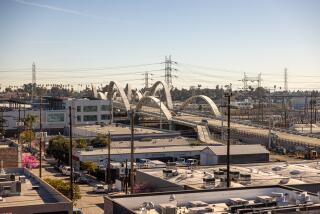Modern Don Quixotes Dream of World’s Tallest Building in Chicago : Architecture: The Miglin-Beitler Tower would be a needle-thin 125 stories. But market forces may crush the vision like a house of cards.
- Share via
CHICAGO — Can the development of the world’s tallest building survive the demise of the Trump era of mega-hype and mega-real estate deals?
That’s the question that seems to bother J. Paul Beitler the most as he and his partner, Lee Miglin, scramble to persuade wary financiers to back their grandiose, $450-million plan to build a pencil-thin, 125-story, 1,999-foot sky-piercer in Chicago’s Loop.
“Donald Trump doesn’t build office buildings; he builds casinos,” Beitler snaps, dismissing the thought that the money won’t come, that Trump’s problems have soured the market. “Donald Trump is in the hype business.”
Then he adds: “I’m going to do it.”
The rest of Chicago’s real estate community isn’t so sure that Miglin and Beitler can pull off their attempt to make architectural history.
“They are good developers, but they are trying something that at this point probably can’t be done,” warns Larry Debb, executive vice president of Mesirow Realty Brokerage, a commercial property firm in Chicago.
If it does get built, the 1.9-million-square-foot Miglin-Beitler Tower, tentatively scheduled to open in 1993, would make quite a sight.
In Chicago, the city that gave birth to the world’s first skyscrapers in the late 19th Century and has been acclaimed for its architecture ever since, Miglin-Beitler would overshadow every structure in town. Most notably, it would look down upon the current holder of the title World’s Tallest Building, the 110-story Sears Tower. The Sears structure stands just two blocks from the parking lot at Madison and Wells streets, where Miglin and Beitler plan to build.
Unlike the ungainly Sears Tower and other ultra-tall buildings that have sacrificed beauty for height, the Miglin-Beitler Tower, designed by renowned architect Cesar Pelli, would add a delicate, needle-like silhouette to the skyline.
Making use of a new, extra-strength concrete that enables a designer to construct a tall building without a wide base--while still maintaining structural stability--Pelli’s New Haven, Conn., firm has sketched out a tower that will be tapered only slightly and will thus appear narrow from bottom to top. It will be so thin that it will fit compactly onto a lot that is smaller than a city block.
The thinness “is one of the best qualities of this building,” Pelli says. “It pierces the sky; the point is so thin, so perfect.
“What is important to me is that we are designing a very graceful building, one that is taking its public responsibility carefully,” he adds. “The two tallest structures today, the Sears Tower and the World Trade Center (in New York), do it with great misgivings. They are not graceful towers with flourishes. They are designs that appear to be small buildings that grew bigger.”
But the tower’s stylistic promise may yet be grounded by more prosaic concerns, such as money.
Beitler insists that Miglin-Beitler Inc. will be able to line up financing for the project by the end of the summer, with groundbreaking later in the year. He says talks have been held with such potential investors as Japanese and American banks and pension funds. To allay bankers’ fears, Beitler says his firm is putting together a partnership that will take a 30% equity stake in the building.
Still, from an economic point of view, the timing of the project could hardly be worse.
In the wake of the savings and loan crisis, a stricter regulatory climate for banks and thrifts is scaring off many financial institutions from sinking money into big real estate projects.
Meanwhile, the commercial real estate market is soft, particularly in downtown Chicago, where millions of square feet of office space is under construction despite a vacancy rate that is 14% and climbing.
And don’t forget the Sears Tower, the white elephant that Sears is fleeing for the suburbs. That means that another million square feet or so of empty space in the old World’s Tallest Building will compete with the 1.2 million square feet in the new World’s Tallest Building.
To top it off, there is Donald Trump and his summer of woes. Trump had gambled that he would insulate himself from the Northeast’s soft real estate market by focusing on “trophy” properties: huge projects, mostly hotels and casinos, that would attract business simply because they were landmarks that bore his name.
It didn’t work. Now, as Trump struggles to survive, analysts say other huge, speculative projects are also coming under closer scrutiny.
Including the Miglin-Beitler Tower.
“Given what’s happened in this market, where lenders are basically saying they are not going to do financing for speculative projects, I can’t imagine how Miglin-Beitler will get financing,” says Deborah Peltz, vice president for marketing and leasing at Rubloff Institutional Real Estate Services, a commercial real estate firm in Chicago.
“I think Miglin-Beitler only has a 30% to 50% chance of getting done,” she adds.
Beitler insists that his odds are much better, and he and Miglin have a record of success in the Chicago real estate market that suggests that they know what they are doing. They have built several skyscrapers in the downtown area and the suburbs, manage 10 million square feet of office space in the Chicago and Milwaukee areas, and are generally considered one of the hottest development teams in Chicago.
“They are known for taking risks that other developers won’t take and making things work,” notes Scott Brandwein, executive vice president of Frain, Camins & Swartchild, a Chicago commercial real estate firm.
Beitler says his project, which has already received city zoning approval, will confound skeptics by targeting a segment of the office market long ignored by developers: the small, yet prestigious, professional firms that want high-profile offices.
The tower’s narrow configuration and relatively small floors have been designed to attract law firms and other tenants that need only 8,000 to 10,000 square feet of space, yet want a status address.
But the tower’s elegantly slim shape may also work against it, analysts argue. Large, corporate tenants are likely to shun the building because their offices would have to be spread across several floors.
As a result, the tower won’t attract a large “anchor” tenant that could absorb a big chunk of its space, reassuring project bankers that there will be steady rent money coming in. By contrast, the Sears Tower’s lower stories have floors that are several times as large as those planned in the Miglin-Beitler Tower.
“They are going to have to get 125 different tenants, each taking up one floor, and there haven’t been that many new tenants on the market wanting that much space in all of Chicago in the last two years combined,” real estate executive Debb says.
Still, Beitler argues that, in the end, lenders and tenants will surface--if for no other reason than to be associated with the world’s tallest building.
“While we are in a strained environment (financially),” acknowledges Beitler, “there is a lot of enthusiasm, because (the potential lenders) say this is a once-in-a-career opportunity.”
More to Read
Inside the business of entertainment
The Wide Shot brings you news, analysis and insights on everything from streaming wars to production — and what it all means for the future.
You may occasionally receive promotional content from the Los Angeles Times.










